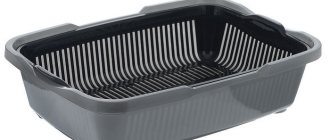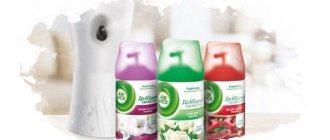The cat regularly relieved itself in the litter box, but suddenly stopped, or were you initially unable to accustom it to this accessory? In both cases, such behavior causes irritation in the owner and stress in the animal (since in most cases a person reveals his dissatisfaction with violent exclamations, or even assault).
Let's figure out why the cat doesn't go to the litter box, how to fix it, how to get rid of the smell of cat urine using household and folk remedies, how to remove the smell of cat urine from textiles,
Why do cats ignore the litter box?
There are several reasons why a cat does not go to the litter box. Let's look at each of them in more detail.
Medical problem
Before you focus your energy on solving the problem of ignoring the litter box, make sure that the animal does not have health problems, if before this the cat went to the litter tray regularly. Get examined by a veterinarian and have a urine test done, which will help determine if your cat has a urinary tract infection. Typically, with diseases of the genitourinary system, cats experience discomfort and pain, which they associate with going to the toilet.
The animal begins to look for other places to relieve itself, where it will not be painful. Often such a place becomes soft surfaces: a blanket, a bed, an armchair, a sofa, a carpet. If the diagnosis is confirmed, your veterinarian will prescribe treatment, and once you have fully recovered, you can begin to address behavioral issues.
Dirty tray
Put yourself in the place of a cat: would you like to go to the toilet that was last cleaned a month ago? We are sure not. Cats are by nature very clean creatures. If they see the litter box is dirty, they will find another place. Murkies often loudly signal that it is high time to clean the toilet. Some especially patient cats will sit near the tray, look questioningly at the person and wait for him to realize that the litter needs to be changed or at least removed with a dustpan.
Closed tray
Some owners think that a house-shaped tray is a great solution that will save them from having to clean up spilled litter every day. However, cats look at the closed litter box with different eyes. They feel uncomfortable in them and often refuse to climb inside. In the heat, the litter remains wet because it does not have time to dry, and instead of hiding the unpleasant odor, the tray house makes it unbearable.
In addition, a closed toilet prevents the cat from escaping in case of danger. In a home with several animals, this can be a real problem. A closed escape route will cause your cat to refuse to go into the litter box, especially if other pets begin to ambush you near the exit.
Wrong tray size
The main rule for choosing a tray is that it must match the size and be 1.5 times longer than the animal.
Incorrect location of the toilet
The location for the tray should be chosen from the point of view of the pet’s convenience and safety, and not because it is convenient for the owner. Avoid placing the toilet near food and water bowls, in a cold, dark basement, next to a washing machine, or in a closet. equipment that may frighten the cat (for example, a washing machine).
Packages at the bottom
Many owners line the bottom with plastic bags for easy cleaning. However, rustling sounds often irritate cats, and they also tear up bedding with their claws when they bury excrement. Urine accumulates in the folds and smells unpleasant.
Not enough filler
Pour at least 5 cm of litter into the tray and maintain its level daily. Cats love to bury their waste deeply, and if there is not enough litter, they will find another place to hide it.
Incorrect filler selected
Most cats prefer litter with small granules, which resembles sand. It is soft, retains odor well, and is convenient for digging. Scented litters often irritate cats; large granules with sharp edges remain on her paws and fur, which is why pets may refuse to use the litter box.
Reference. Some cats do not hide their waste in the litter. Firstly, they are simply lazy, and secondly, the mother cat did not teach this from an early age. Also, dominant cats do not cover their excrement - in this way they demonstrate who is the “master” of the house.
High tech trays
Electronic trays with a self-cleaning function have many disadvantages:
- most of them are equipped with motors that scare cats;
- they look bulky on the outside, but the actual space inside is too small for a cat;
- Such trays have lids.
In addition, in most cases, they are designed for one animal and begin cleaning 10 minutes after the cat goes outside, and do not take into account that a second cat may come in after. One can only imagine what a storm of emotions the noise during cleansing will cause in the mustachioed man. Another disadvantage is that the owner is deprived of the ability to control the contents of the tray. The ability to check the toilet daily is a guarantee of your pet's health. You can see whether your cat has diarrhea or is constipated by how often she goes to the toilet.
Using caustic cleaning agents
Strong-smelling household chemicals can scare away your cat. Do not wash the tray with concentrated bleach or dishwashing detergent with a strong aroma. Even if you use such liquids, rinse them thoroughly with running water.
Reference. Cats have 67,000,000 receptors, humans have 5,000,000.
Rugs near the tray
There are mats on the market that are designed to trap particles of litter that stick to the paw pads when the cat leaves the litter box. Some coverings have a texture that animals find unpleasant and therefore ignore the litter box.
Best Tray for Odor Retention
If the owner initially decides that the house should not “smell” of cat excrement, but at the same time cannot clean out his pet’s toilet after every successful trip, then it is worth taking a closer look at trays that prevent the smell from spreading.
- Closed tray - in addition to retaining the smell, it prevents the scattering of the filler during intensive “burying”. In addition, it is an excellent option for modest pets who do not want to do their business in front of everyone and those who go to the toilet by. You can purchase a model equipped with or without a door, regular or corner.
- A dry closet equipped with a carbon filter is an effective, but expensive device that has impressive dimensions. Modern models have a fan that blows foul-smelling air to the filter. Requires regular filter replacement.
- The Automatic Cleaning Litter is an odorless cat litter that is a high-tech device that sifts and collects soiled litter. A number of fixtures are connected to the sewer and water supply lines. Naturally, the price of such a tray is quite high.
But it’s not just the tray that determines how intensely a specific aroma spreads in the room. An important point is the selection of a suitable filler.
Remedies for cat odor
Regular cleaning, washing the floors and litter box will help eliminate cat odor in the house. You can use both household chemicals and folk remedies.
Household chemicals
List of effective remedies for cat urine:
- ENZ-ODOURS from the manufacturer Arrow helps neutralize unpleasant odors and remove stains;
- floor cleaner from Mr.Fresh;
- wet wipes for pet cleaning from Teddy Pets;
- "Lina" means for cleaning, disinfection, elimination of odors and stains from "Hemiline";
- odor eliminater “True Friend” from;
- “Spray for cleaning cat litter” from “Pchelodar”;
- “Bionit” for disinfection of animal housing from Bioneat;
- “Functional odor eliminator for cat litter with peach scent” in tablet form from Japan Premium Pet;
- Extreme odor eliminator from Espree;
- spray for eliminating odor in cat litter NODOR LITTER SPRAY UNSCENTED from Hartz.
Traditional methods
List of folk remedies:
- Potassium permanganate solution is an excellent cat urine odor neutralizer that eliminates unpleasant odors and has a disinfecting effect. Suitable for removing odors and stains from furniture upholstery, however, when preparing the solution, you need to ensure that the crystals are completely dissolved.
- Table vinegar 9%. To prepare the solution, you need to mix 1 part vinegar with 3 parts water, treat the surface and let the solution dry. Then sprinkle the area to be treated with baking soda, treat with a wet sponge and rinse with clean water. To treat furniture upholstery, carpets and mattresses, it is better to pour the solution into a container with a spray bottle and spray it onto the surface.
- Baking soda. Powder is poured onto a fresh stain and wiped with a wet sponge or brush. Old stains are removed as follows: scatter baking soda and sprinkle with 3% hydrogen peroxide. As a result of the reaction, an ammonia odor will be released, which will quickly disappear. If the stain is persistent, leave the product on for 12 hours and then wash off with clean water. Soda is suitable for cleaning upholstered furniture and mattresses.
- Citric acid or lemon juice will help get rid of unpleasant odors. Add the juice of 1 lemon or 10 g of citric acid to 200 ml of water. The prepared solution is used to treat furniture, floor coverings of any type and carpets. Cats do not like the smell of citrus fruits, so after such treatment they rarely shit in the same place.
- Vodka effectively eliminates the smell of cat urine, and also disinfects surfaces and easily copes with fresh stains. The smell of alcohol disappears quickly. The product is suitable for any surface.
How and what to clean cat litter with
Even if the tray is in very poor condition, this is not a reason to go buy a new one. Why spend extra money if even an old toilet can be tidied up? Urine stones can be removed from the tray with just one thorough cleaning. You will need:
- Garbage bag;
- Water;
- Detergent;
- Hard brush;
- Rag;
- Gloves.
To protect yourself from various parasites when cleaning your cat's litter box, be sure to wear gloves. Only after this can you start cleaning the cat litter. To do this, first turn out the entire contents of the tray into a garbage bag. It is best to immediately take the bag with such contents to the trash bin. The next step is to thoroughly rinse the tray under running water to remove any remaining cat feces. After this, a detergent such as Domestos or any other, preferably for washing toilets, is poured into the tray. All that remains is to thoroughly and forcefully wipe the tray with a stiff brush. You will have to rub with effort.
How to remove urine from different surfaces
Household chemicals, the list of which we have already given, are suitable for removing urine from floor coverings. Eliminating unpleasant odors from fabric and shoes is more difficult, but this task can also be dealt with using available means.
Eliminating odor from shoes
Shoe cleaning products:
- mix table vinegar with water and treat the surface;
- dissolve 10 g of citric acid in 200 ml of warm water;
- treat shoes with wet soda, then rinse with running water;
- to clean shoes made of genuine leather and suede, use glycerin, which perfectly eliminates unpleasant odors;
- prepare a weak solution of potassium permanganate for treating shoes made of dark textiles.
Algorithm for removing stains from shoes:
- It is enough to rinse fresh stains with water or treat them with napkins to eliminate odors;
- Wash shoes that have recently been damaged with warm water;
- when using potassium permanganate, vinegar, soda and glycerin, do not rub them into the shoes too intensely so as not to spoil the material;
- When finished cleaning, rinse your shoes with clean water.
You can also use professional products in the form of sprays, which are sold in every pet store.
How to remove cat urine from blankets and mattresses
How to remove the smell of cat urine without damaging the fabric? An old, but time-tested remedy - laundry soap - will help remove urine stains and eliminate unpleasant odors. Wet the surface and treat with a bar of soap. Leave on for a few minutes and rinse off with a damp sponge. Take the blanket or mattress out into the sun and dry thoroughly.
How to remove odor from bedding and clothes
Lemon juice will help remove the smell of cat urine from clothes. Take the juice of one lemon for 250 ml of water, mix, pour into a container with a spray bottle, and thoroughly treat the stain. After half an hour, wash in your usual way.
How to clean the floor
To clean floors, you can use household chemicals, which perfectly disinfect and refresh surfaces, and also use a vinegar solution.
Causes of persistent unpleasant odor
It is clear that without understanding the reasons why cat urine has such a persistent and strong odor, it is completely useless to think about how to remove the cat odor. You don’t need to be a professional chemist to figure it out and then find methods to eliminate the problem.
Photo from the site: 29palms.ru
- Uric or uric acid is our main “enemy”, which is the most difficult to fight. This substance dries out very quickly and crystallizes, after which it is practically insoluble either in water or in most household cleaning products. But it dissolves well in acidic environments, which is why vinegar, citric acid, and alkali solutions are called effective.
- The second component of urine is urochrome, a substance that gives the liquid a persistent yellow tint that leaves stains. It washes off quite well with any cleaning solution, but best of all with glycerin soap.
- Urea gives the cat’s “surprises” stickiness; it is easily washed off with plain water, and this definitely won’t cause any problems.
Uric acid “knows how” to camouflage itself very well. That is, when cleaning up traces of a “crime,” you can mask the unpleasant odor with aromatic fragrances, but after they dissipate and moisture gets on the acid crystals, they will “smell” even more strongly. It is more difficult to remove the smell of urine from soft surfaces, for example, from furniture, but easier to remove from the floor. The main thing is that urine does not seep through or be absorbed into the floor covering, otherwise it will have to be replaced completely or at least partially.
Prevention
Prevention methods:
- Sift the litter twice a day, remove excrement on time, and wash the tray with special products once every two weeks.
- If you don't use litter, clean your cat's litter box every day.
- If there are several cats living in an apartment, you must provide a litter box for each of them. As a last resort, buy one large tray for two animals, and also have a spare one.
- Choose a litter for your pet based on its preferences. Some cats prefer wood litter, others clay, and still others clumping. Silica gel is considered the most hygienic, but it is not suitable for all cats. Some animals start eating it, others refuse to go into the tray because the sharp edges of the granules hurt their sensitive paws.
- To prevent your cat from using your shoes as a toilet, treat the soles with alcohol. Store shoes, sneakers and boots in closed drawers or special cabinets.
Use deodorant
You can use baking soda as a deodorizer for your cat's litter box. There are also various perfumes or additives available in the market that can help keep the litter box odorless.
However, your kitten may not like the smell and may refuse to use the litter box as a result. You should try and experiment using these additives one at a time to find a deodorant that your cat likes. There are also unscented deodorants available that you can spray a little deodorant into each time you clean your kitty's litter box. However, veterinarians do not recommend using deodorant.
Woman wearing a gray spaghetti strap cleaning the blue little box or cat toilet, feeling stinky
Misconceptions
Some cat owners mistakenly believe that they can get rid of the smell of cat urine using perfume and diligently treat the stains with cologne. However, this approach is fundamentally wrong: perfume will only hide the smell for a while, but soon you will feel the whole spectrum of unpleasant aromas. The interaction of the smell of cat urine and the scent of lily of the valley is a hell of a mixture.
Chlorine-containing products will also not save you and your home from the unpleasant odor. Chlorine itself smells terrible; it’s difficult to get rid of its smell even after airing for many hours, let alone textiles or, for example, shoes. In addition, such drugs have a bad effect on the human and animal body.
Caring for your cat's litter box
Caring for your cat's litter box is not difficult. The main actions of the cat owner are:
- timely cleaning of solid animal feces;
- regularly changing urine-soaked litter in the container;
- washing the tray.
If all actions are carried out regularly and in full, then the animal will not relieve itself by passing or do it in unintended places.
Animals from the order of cats are distinguished by their intelligence and have excellent memory. Their habit is to bury the products of their vital activity in the ground so that “enemies” cannot find them by smell. This is why cat litter is filled with cat litter. Also, by smell, they find pairs for procreation, mark and limit “their” territory, and the kittens, thanks to their heightened sense of smell, find the litter box and become accustomed to visiting it. And that is why adult animals ignore places to relieve themselves that are kept in poor order by the owners of the animals.
Dietary disorders, stress, age-related changes in the animal’s body and other external factors lead to the animal’s urine becoming caustic and salts forming in it. Fresh deposits can be removed when replacing the filler, but uric acid or oxalates can only be removed mechanically.
By my rules
Proper washing of the cat's litter box is the key to freshness and a pleasant smell in the apartment. The sequence of actions of this process depends entirely on the design and shape of the cat litter being used.
Open trays need to be cleaned more often than closed trays. Daily cleaning generally does not require a complete change of litter; it will be enough to collect the excrement and then dispose of it in accordance with the recommendations indicated on the packaging of the desiccant mixture.
If the cat relieves itself not in the litter itself, but on the grate, then it is recommended to wash it with each cleaning. For this purpose, it is advisable to use special products designed for sanitizing cat litter. The action of such products is aimed at the complete sanitization of cat litter, so the substance can easily cope with the smell of urine and prevent the deposition of salts.
General cleaning of the cat litter is carried out in the order listed below:
- Empty the tray. Unused filler (especially silicone) can be collected in a separate container and reused.
- Fill the tray with warm water up to the ears, and soak the grate in a separate container.
- We leave the tray with water for ten minutes, and then rinse it and drain the water from the pan.
- Place the tray and grill in a bowl of soapy water, and then leave them there for half an hour.
- After the time has passed, drain the dirty water and treat the surface of the cat litter with a detergent and then scrub with a brush.
- Carefully rinse off any remaining soap and rinse the containers clean.
- We wipe the tray and grill dry or dry it in the fresh air.
Some cat owners recommend having two replaceable trays so that the animal does not experience discomfort while sanitizing its litter box.
Despite the fact that a cat or cat is undoubtedly a favorite, and caring for them is not a burden or disgusting, all work on disinfecting a cat's litter box should be done exclusively with rubber gloves. This will not only protect the skin of your hands from exposure to household chemicals, but also protect against toxoplasmosis. This disease is especially dangerous for pregnant women. Its causative agent, entering the body of the expectant mother, can cause deformities and other abnormalities in the child in the womb.
To wash all parts of the tray, you can use traditional detergents and chlorine-containing substances (Domestos, Belizna and others), as well as special compounds that eliminate the smell of cat urine. When disinfecting the toilet with special chemicals, there is no fear of the formation of urinary stones on the surface of the container. Sprays and powders not only eliminate simple dirt and the specific smell of urine, but also fight pathogens.
If you do not have such means, then you can wash the trays with laundry detergent or any detergent compositions, including improvised ones. But as a result of this, everyone will inevitably have to face other problems. Read about them and their solution below.
Clearing urinary stones
Often, cat owners wash the litter box just to keep the smell out of it. But they forget that untimely or incorrect cleaning of the tray, as well as the use of inappropriate surface treatment products, lead to the deposition of urinary stones. The manifestations of this unpleasant phenomenon are:
- foul odor;
- plaque, noticeable as growths that are rough to the touch;
- refusal of the animal to visit the tray.
An animal that relieves itself in a tray with stone deposits will spread the “aroma” throughout the apartment on the pads of its paws. To avoid urine transfer, and with it possible infection, attention should be paid to combating natural salts.
Special means
In any pet store you can find a special product for cleaning trays and eliminating unpleasant odors. They can be used both for disinfection and for removing urinary stones on the walls and bottom of the tray. They do not cause allergic reactions in pets, have a pleasant or neutral odor, do not leave scratches and remove the odors of feces and urine. Hartz and Joypet sprays, Super Benek powder, and Mr. plaque and urinary stone cleaner are very popular. Fresh. The main disadvantage of these funds is the rather high price (500-800 rubles). Washing with plain water does not have sufficient effect. Using white when cleaning the litter box will eliminate the odor, but your pet may refuse to go to the toilet after this treatment. Using vinegar is a temporary measure. The unpleasant smell will not go away for long, and the vinegar itself stinks no worse than your pet’s urine.
A big problem is limescale deposits on the walls of the tray. This problem can be dealt with in two ways. You need to give your cat boiled water and not feed it food that is high in salt. After each visit to the toilet, the tray should be rinsed with running water.
Causes of unpleasant smell in the refrigerator and how to get rid of it
Why do you need to wash the litter box regularly?
Many owners believe that when they change the filler, the smell goes away, but this is a mistaken opinion. If a person does not carefully monitor the cleanliness of the litter box, the cat may simply prefer, for example, slippers to a dirty toilet.
And he will do this not out of harm, but because by his nature he cannot relieve himself in a dirty place.
In addition, lack of hygiene measures can lead to other problems:
- Urinary stone deposits. This is the main source of heavy odors in the house. You can clean the tray from plaque using household detergents, the main thing is to rinse them off thoroughly. After all, foreign chemical odors are also unpleasant for cats.
- Toxoplasmosis. This is a disease caused by single-celled parasites found in the feces of infected animals. If feces are not removed promptly, humans can become infected with toxoplasmosis. Toxoplasmosis is especially dangerous for pregnant women.
To avoid these problems, you need to clean the tray daily. And change it completely, at least once every 3 days.
Video
Some more useful information is presented in the video below:
Text: Nadezhda Chernobay
Found a mistake? Select the text with the mouse and click:
There are special traps to combat moths. The sticky layer with which they are covered contains female pheromones that attract males. By sticking to the trap, they are eliminated from the reproduction process, which leads to a decrease in the moth population.
Stretch ceilings made of PVC film can withstand from 70 to 120 liters of water per 1 m2 of their area (depending on the size of the ceiling, the degree of its tension and the quality of the film). So you don’t have to worry about leaks from neighbors above.
If your favorite things show the first signs of gestation in the form of untidy pellets, you can get rid of them using a special machine - a shaver. It quickly and effectively shaves off clumps of fabric fibers and returns things to their proper appearance.
Fresh lemon is not only suitable for tea: clean dirt from the surface of an acrylic bath by rubbing with half a cut citrus, or quickly wash the microwave by placing a container of water and lemon slices in it for 8-10 minutes at maximum power. The softened dirt can simply be wiped off with a sponge.
The dishwasher cleans more than just plates and cups. You can load it with plastic toys, glass lamp shades and even dirty vegetables, such as potatoes, but only without using detergents.
The habit of using an automatic washing machine “sparingly” can lead to the appearance of an unpleasant odor in it. Washing at temperatures below 60℃ and short rinses allow fungi and bacteria from dirty clothes to remain on internal surfaces and actively multiply.











